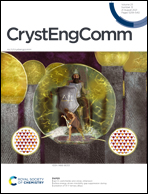Bent-bis(triazolyl)-based coordination polymers tuned by dicarboxylate ligands: syntheses, structures and properties†
Abstract
Seven bent-bis(triazolyl)-based coordination polymers, [Zn(opbt)(nbdc)(H2O)]n (1, opbt = 1,1′-(oxybis(1,4-phenylene))-bis(1H-1,2,4-triazole), nbdc2− = 5-nitrobenzene-1,3-dicarboxylate), [Cd2(opbt)(cpa)2(H2O)]n (2, cpa2− = 2-carboxyphenylacetate), {[Cd(opbt)(sdb)(H2O)]·2H2O}n (3, sdb2− = 4,4′-sulfonyldibenzoate), [Co2(opbt)2(nbdc)2]n (4, nbdc2− = 5-nitrobenzene-1,3-dicarboxylate), {[Zn(opbt)(cydc)]·H2O}n (5, cydc2− = 5-cyano-1,3-benzenedicarboxylate), {[Zn(opbt)(mbdc)]·(G*)}n (6, mbdc2− = 5-methylbenzene-1,3-dicarboxylate, G* = 0.25DMF·0.5H2O·0.5H2mbdc) and {[Cd(opbt)(chdc)]·H2O}n (7, chdc2− = cis-1,2-cyclohexanedicarboxylate), were successfully synthesized in the presence of different auxiliary ligands. Compound 1 displays a 1D polymeric chain and the adjacent chains are further linked by hydrogen bonds to afford a 3D supramolecular architecture. Compound 2 is a 3D framework and exhibits a 3,3,3,3,3,5,7-connected 7-nodal net with the point symbol {3·4·5}{3·5·6}3{32·43·52·95·108·11}{4·62}2{43·5·62·94}. Compound 3 exhibits a three-fold interpenetrated 3D network with a 4-connected uninodal net with the point symbol {44·62}. Compound 4 is a 2D layer architecture. These layers are further regularly packed into a 3D supramolecular framework through π–π stacking interactions. Compound 5 reveals a four-fold interpenetrated 3D framework possessing a 4-connected dia network with the point symbol {66}. Compound 6 consists of 2D protuberant layers with the sql topology. These layers are further packed through π–π stacking interactions in an ABAB manner, resulting in the formation of a 3D supramolecular structure. Compound 7 possesses a 2D layer, which is further extended into a 3D supramolecular framework through interlayer π–π stacking interactions. These results indicate that the versatile coordination networks of opbt and the various dicarboxylate ligands play crucial roles in modulating the structural topologies of coordination networks. In addition, their thermal stabilities and photoluminescence properties were also investigated.

- This article is part of the themed collection: Coordination Networks


 Please wait while we load your content...
Please wait while we load your content...